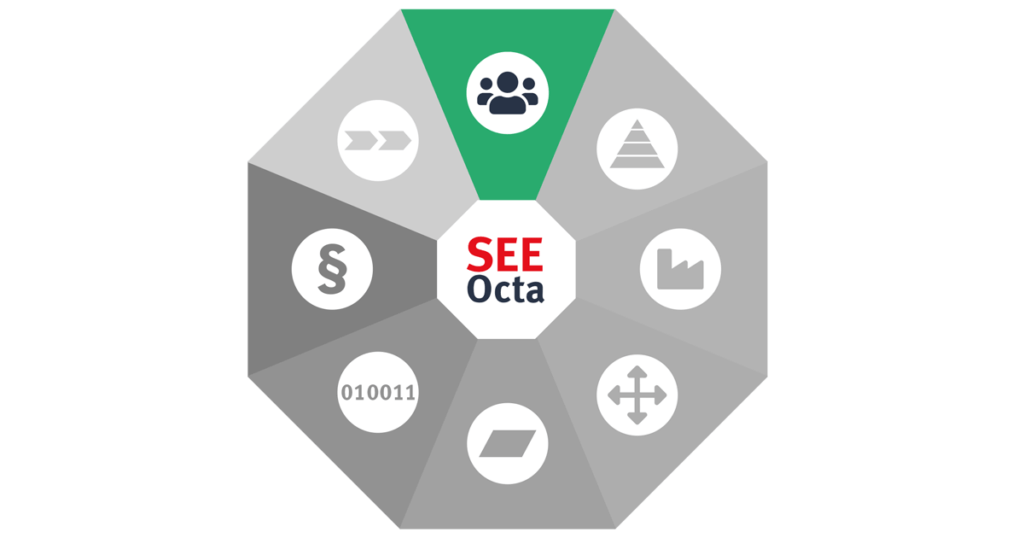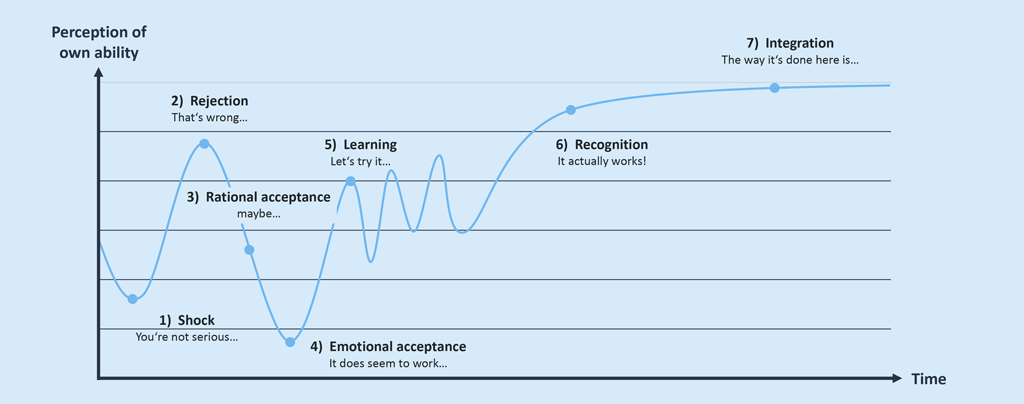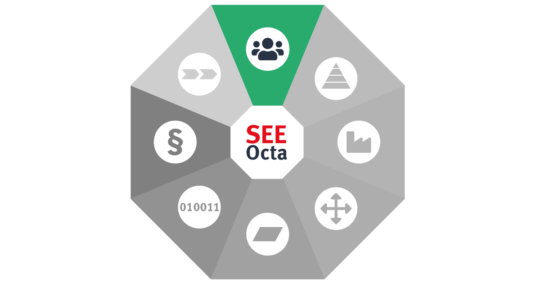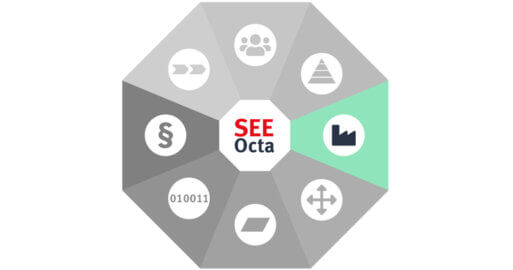SEEOcta – How Staff and Change Management are Part of successfully Managing a Project

Introducing new IT projects requires a lot of tact in dealing with your employees. You can’t assume automatic acceptance for the project, indeed, there will probably be a lot of anxiety and insecurity, with some staff rejecting the changes outright. A well-planned, targeted communication strategy goes some way towards alleviating some of these worries and concerns. Further valuable approaches to smooth the way towards starting a new IT project can be found in change management. Read on to find out more about the role of change management in SEEOcta concept from SEEBURGER.
Digitalisation has been progressing at such a rapid pace that these days, companies are placed under enormous pressure to change. Processes need to be adjusted, adapted and optimised, and new systems need to be rolled out. This means that IT projects are hastily started, however, according to a Forrester study, only 40% of these are actually successful[1]. Projects go over time and budget and the goals set are only partially achieved. A significant reason why projects fail is that, in many cases, projects are planned without considering the factor ‘people’. Alongside a carefully considered communication plan – described in our post SEEOcta – Successful and Purposeful Communication with Staff – in order to be successful, your IT project needs to be employ methods from change management.
Build acceptance with tools from change management
That people view change with suspicion is not a new phenomenon. On the contrary, throughout evolution, this suspicion has been invaluable for protecting ourselves for the dangers which may be lurking within the unknown. It’s a primitive instinct which has never quite left us. It’s only when someone can be persuaded that he has nothing to fear, or better, that he will benefit from new developments, that he is actually able to accept them. This is what we want to achieve through intelligently employing tools from change management. Particularly at management level, people fear losing the authority they’ve spent years building up as the knowledge and skills they’ve gathered over years probably won’t count for anything in the new environment. Instead, they’ll need to start almost from new, maybe also having to adapt to new organisational structures. Not everyone is prepared to take on these challenges.
The more complex an IT project, the more essential it is to employ methods from change management to enable staff to ease into their new roles and be willing to participate in the change process. The first step in managing the change is to employ a carefully considered communication plan to provide the employees affected with all the information they need to help them decide whether and how to accept the changes. Indeed, a proactive communication strategy can help significantly reduce the length of a project, in some cases by 12 months or more! Involving your staff gives you the opportunity to recognise resistance early on and to work on breaking this down. This naturally helps costs remain in budget and also reduces that staff resistance causes a project to fail.
Beim Change-Management die emotionale Entwicklung berücksichtigen
How on earth can a project be resisted so strongly by employees that it fails? Isn’t it enough to simply focus on the existing structures and align the change management processes to these? Of course not, because to do so would be to ignore a major factor; the emotions which change triggers in your staff. Prof. Dr. Richard K. Streich, professor of behavioural and economic sciences at the University of Padeborn, Germany, has studied human behaviour when confronted with change. In his research, he discovered that on both an individual and an organisational level, this behaviour tends to follow a particular pattern, which can be illustrated as a curve divided into seven stages. These begin with the shock that announcing a new IT system triggers in staff, and culminates in the integration stage, in which the changes have been so well accepted that they have been integrated into the fabric of everyday business life. At each stage there are peaks and troughs in activity, productivity and motivation. By considering these seven stages in your staff’s emotions, you can help your project run significantly more smoothly.

The seven emotional stages in change management
Stage 1: Shock
The ways in which people naturally react to comprehensive change being announced range from surprise to shock. If an employee is satisfied with his current situation, he may find it difficult to come to terms with the planned new measures. The more established an employee perceives his role to be within a department, the more likely he is to feel threatened and to fear the planned changes. Does he have the right skills for what is now being demanded of him? Will he still be needed? A classic effect at this stage is a slump in productivity, as the old way of doing things just isn’t effective any more.
Change management measure: An information offensive – a sympathetic yet intensive information flow to those affected.
Stage 2: Rejection & denial
Once an employee has overcome the initial shock, the planned change is often greeted with rejection and denial. This can lead staff to band together and resist the planned change, declaring it to be completely unnecessary. They’re likely to try and tell themselves that the changes planned are pointless, and not worth supporting. Everything works fine the way it is, doesn’t it? It doesn’t need changing…
Change management measure: Consistency. Keep on reassuring employees as doubts about the planned measures need to be laid to rest as soon possible.
Stage 3: Rational acceptance
If the change has been managed successfully thus far, the employees affected should be starting to recognise that the planned changes are unavoidable and necessary. However, accepting something on a rational level doesn’t necessarily mean that it’s been accepted on an emotional level. On the contrary, initially the new circumstances will feel awkward, and there will be some attempt to escape, avoid or ignore them. If these attempts don’t work, employees are likely to become frustrated.
Change management measure: Encourage staff to personally and actively engage with the change process.
Stage 4: Emotional acceptance
In this decisive stage, we have reached the lowest point of the arc, but also the turning point. The attempts to avoid, ignore or escape the situation have decisively failed. The frustration employees are feeling has led them to completely doubt their ability. This is where people are starting to give up. However, this also gives them the space they need to accept the inevitable on an emotional level. Now the introduction of the new processes can really begin.
Change management measure: Workshops and opportunities for dialogue to accompany and support staff in this reorientation stage.
Stage 5: Learning and testing
In this stage, each member of staff needs to explore and discover how the new processes could work for them. Which skillset would work best in which team? Willingness to learn, flexibility and creativity are called for, the extent of which is often underestimated by managers. This is unfortunate, as their willingness to allow mistakes and to give staff enough space to experiment and learn is just as importance as accepting the new processes is on the employees’ side. This approach could allow new interdisciplinary and cross-departmental cooperations to naturally spring up and evolve, providing clear prospects for future cooperation. This new, positive environment contributes to the productivity level in this stage continuously increasing.
Change management measure: Patient support and encouragement by all with staff responsibilities. Assigning new tasks commensurate with an employee’s skillset.
Stage 6: Recognition
At this point, it’s important to start nurturing and developing employees‘ skills. Staff will have benefitted from their experimental, learning stage with positive experiences which will have increased their self-esteem. They will have a more positive view of their skills and abilities and, in general, the changes and their effects will be viewed increasingly more positively. Staff will have gained new skills and knowledge and the future will no longer be looking bleak, rather promising.
Change management measure: Make successes tangible and celebrate them!
Stage 7: Integration
This last stage is characterised by the new skills and knowledge being fully integrated into daily business. The content of the training in the previous phase is being put into practice. The new processes are now established and employees have found their place in the new order. This positive development is reflected not only in increased productivity, but also in an increased ability to deal with and embrace change within the entire organisation. This experience will help future change processes run quicker and more smoothly.
In conclusion
A knowledge of the seven stages of change is enornously helpful when preparing for a change project. You are able to anticipate employees‘ reactions and plan appropriate measures for these in advance, insofar as emotions are plannable. And that is the challenge of managing change when introducing a new IT project.
[1] https://www.silicon.de/41591125/60-prozent-aller-it-projekte-nicht-im-plan
[2] Image based on that of C. Kostka / A. Mönch (2002) Page 11
Thank you for your message
We appreciate your interest in SEEBURGER
Get in contact with us:
Please enter details about your project in the message section so we can direct your inquiry to the right consultant.
Written by: Rolf Holicki
Rolf Holicki, Director BU E-Invoicing, SAP&Web Process, is responsible for the SAP/WEB applications and digitization expert. He has more than 25 years of experience in e-invoicing, SAP, Workflow and business process automation. Rolf Holicki has been with SEEBURGER since 2005.



